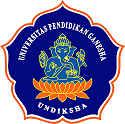Pengaruh Model Pembelajaran Process Oriented Guided Inquiry Learning (POGIL) terhadap Kemampuan Pemecahan Masalah dan Self Efficacy Siswa SMP
Abstract
Penelitian ini bertujuan untuk menganalisis perbedaan kemampuan pemecahan masalah (KPM) dan self-efficacy (SE) antara kelompok siswa yang belajar dengan model pembelajaran Process Oriented Guided Inquiry Learning (MP.POGIL) dan model pembelajaran direct instruction (MP.DI). Penelitian ini tergolong penelitian eksperimen semu dengan rancangan pretest-posttest nonequivalent control group design. Sampel penelitian adalah 120 siswa kelas VIII SMP N 2 Semarapura yang diambil dengan teknik simple random sampling. Data dikumpulkan dengan tes KPM dan kuisioner SE. Data dianalisis dengan menggunakan statistik deskriptif dan MANOVA satu jalur. Untuk mengetahui besar perbedaan digunakan uji Least of Significance Differences (LSD) pada taraf signifikansi 5%. Hasil penelitian menunjukkan bahwa: (1) terdapat perbedaan KPM dan SE antara kelompok siswa yang belajar dengan MP.POGIL dan MP.DI (F = 86,424; p<0,05), (2) terdapat perbedaan KPM antara kelompok siswa yang belajar dengan MP.POGIL dan MP.DI (F=120,634; p<0,05), (3) terdapat perbedaan SE antara kelompok siswa yang belajar dengan MP.POGIL dan MP.DI (F=51,104; p<0,05). Berdasarkan uji lanjut dengan LSD, diperoleh bahwa skor rata-rata KPM dan SE siswa kelompok MP.POGIL dan MP.DI berbeda secara signifikan, skor rata-rata KPM dan SE yang dicapai oleh kelompok siswa yang belajar dengan MP.POGIL lebih tinggi dibandingkan dengan MP.DI.
Kata Kunci : model pembelajaran POGIL, kemampuan pemecahan masalah, self-efficacy
The study was aimed at analyzing the differences of the capability in problem solving (KPM) and self efficacy (SE) between student’s group who were managed with Process Oriented Guided Inquiry Learning model (MP.POGIL) and direct instruction model (MP.DI). This research is quasi experiments with using pretest-posttest nonequivalent control group design. The subject of this experiment was 120 eighth grade students of SMP N 2 Semarapura in the academic year of 2013/2014 which were used as samples were chosen by using random sampling technique. Data was collected by using the KPM test and SE questioner. The data was analyzed by using descriptive statistics and one way of MANOVA. Least of Significance Differences (LSD) was used to compare the pair means among groups and it was at 5% level of significances. Based on research, it was found: (1) there was significant difference of KPM and SE between student’s group who were managed with MP.POGIL and MP.DI (F = 86,424; p<0,05), (2) there was significant difference of KPM between student’s group who were managed with MP.POGIL and MP.DI (F=120,634; p<0,05), and (3) there was significant difference of SE between student’s group who were managed with MP.POGIL and MP.DI (F=51,104; p<0,05). LSD analysis showed that MP.POGIL was superior than MP.DI in both the capability in problem solving and self-efficacy.
keyword : POGIL learning model, the capability in problem solving , self-efficacy
Kata Kunci : model pembelajaran POGIL, kemampuan pemecahan masalah, self-efficacy
The study was aimed at analyzing the differences of the capability in problem solving (KPM) and self efficacy (SE) between student’s group who were managed with Process Oriented Guided Inquiry Learning model (MP.POGIL) and direct instruction model (MP.DI). This research is quasi experiments with using pretest-posttest nonequivalent control group design. The subject of this experiment was 120 eighth grade students of SMP N 2 Semarapura in the academic year of 2013/2014 which were used as samples were chosen by using random sampling technique. Data was collected by using the KPM test and SE questioner. The data was analyzed by using descriptive statistics and one way of MANOVA. Least of Significance Differences (LSD) was used to compare the pair means among groups and it was at 5% level of significances. Based on research, it was found: (1) there was significant difference of KPM and SE between student’s group who were managed with MP.POGIL and MP.DI (F = 86,424; p<0,05), (2) there was significant difference of KPM between student’s group who were managed with MP.POGIL and MP.DI (F=120,634; p<0,05), and (3) there was significant difference of SE between student’s group who were managed with MP.POGIL and MP.DI (F=51,104; p<0,05). LSD analysis showed that MP.POGIL was superior than MP.DI in both the capability in problem solving and self-efficacy.
keyword : POGIL learning model, the capability in problem solving , self-efficacy
Refbacks
- There are currently no refbacks.
Jurnal ini diterbitkan oleh :
Universitas Pendidikan Ganesha
Jurnal Pendidikan dan Pembelajaran IPA Indonesia is licensed under a Creative Commons Attribution-ShareAlike 4.0 International License.
Jurnal Pendidikan dan Pembelajaran IPA Indonesia indexed by:





Jurnal Pendidikan dan Pembelajaran IPA Indonesia is licensed under a Creative Commons Attribution-ShareAlike 4.0 International License.








